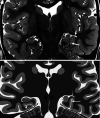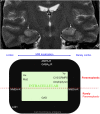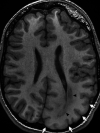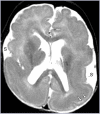The changing landscape in epilepsy imaging: Unmasking subtle and unique entities
- PMID: 35997478
- PMCID: PMC9682800
- DOI: 10.5152/dir.2022.21339
The changing landscape in epilepsy imaging: Unmasking subtle and unique entities
Abstract
Dramatic changes have occurred recently in the field of epilepsy, including a fundamental shift in the etiology of epileptogenic substrates found at surgery. Hippocampal sclerosis is no longer the most common etiology found at epilepsy surgery and this decrease has been associated with an increase in the incidence of focal cortical dysplasia and encephaloceles. Significant advances have been made in molecular biology and genetics underlying the basis of malformations of cortical development, and our ability to detect epileptogenic abnormalities with MR imaging has markedly improved. This article begins with a discussion of these trends and reviews imaging techniques essential for detecting of subtle epilepsy findings. Representative examples of subtle imaging findings are presented, which are often overlooked but should not be missed. These include temporal lobe encephaloceles, malformations of cortical development (and especially focal cortical dysplasia), hippocampal sclerosis, hippocampal malformation (also known as HIMAL), ulegyria, autoimmune encephalitis, and Rasmussen's encephalitis. Recent findings on the pathophysiology and genetic underpinnings of several causes of localization-related epilepsy are incorporated. For instance, it has been recently found that focal cortical dysplasia IIb, tuberous sclerosis, hemimegalencephaly, and gangliogliomas are all the result of mutations of the mTOR pathway for cell growth.
Conflict of interest statement
Figures













Similar articles
-
Neuroimaging and genetic characteristics of malformation of cortical development due to mTOR pathway dysregulation: clues for the epileptogenic lesions and indications for epilepsy surgery.Expert Rev Neurother. 2021 Nov;21(11):1333-1345. doi: 10.1080/14737175.2021.1906651. Epub 2021 Mar 31. Expert Rev Neurother. 2021. PMID: 33754929
-
Profiling PI3K-AKT-MTOR variants in focal brain malformations reveals new insights for diagnostic care.Brain. 2022 Apr 29;145(3):925-938. doi: 10.1093/brain/awab376. Brain. 2022. PMID: 35355055 Free PMC article.
-
Targeting the Mammalian Target of Rapamycin for Epileptic Encephalopathies and Malformations of Cortical Development.J Child Neurol. 2018 Jan;33(1):55-63. doi: 10.1177/0883073817696814. Epub 2017 Mar 16. J Child Neurol. 2018. PMID: 29246093 Free PMC article.
-
mTOR signaling in epilepsy: insights from malformations of cortical development.Cold Spring Harb Perspect Med. 2015 Apr 1;5(4):a022442. doi: 10.1101/cshperspect.a022442. Cold Spring Harb Perspect Med. 2015. PMID: 25833943 Free PMC article. Review.
-
Precision Therapy for Epilepsy Related to Brain Malformations.Neurotherapeutics. 2021 Jul;18(3):1548-1563. doi: 10.1007/s13311-021-01122-6. Epub 2021 Oct 4. Neurotherapeutics. 2021. PMID: 34608615 Free PMC article. Review.
Cited by
-
Glial transformation of a DNET: About a case.Radiol Case Rep. 2024 Oct 4;20(1):64-68. doi: 10.1016/j.radcr.2024.09.104. eCollection 2025 Jan. Radiol Case Rep. 2024. PMID: 39429708 Free PMC article.
-
A rare cause of postpartum seizure: Cerebral tuberculoma.Radiol Case Rep. 2024 Apr 4;19(6):2487-2491. doi: 10.1016/j.radcr.2024.03.008. eCollection 2024 Jun. Radiol Case Rep. 2024. PMID: 38585387 Free PMC article.
-
Calcified intracranial epidermoid cyst presented during pregnancy: A case report.Radiol Case Rep. 2025 May 15;20(8):3738-3743. doi: 10.1016/j.radcr.2025.04.103. eCollection 2025 Aug. Radiol Case Rep. 2025. PMID: 40486142 Free PMC article.
References
MeSH terms
Substances
Grants and funding
LinkOut - more resources
Full Text Sources
Medical
Miscellaneous

